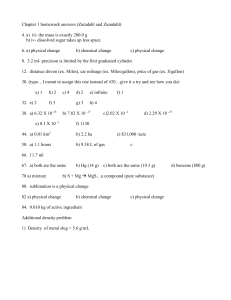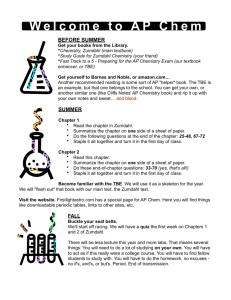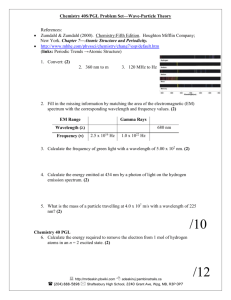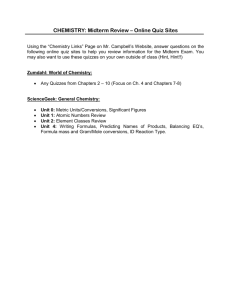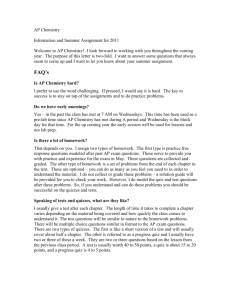Separation Techniques
advertisement
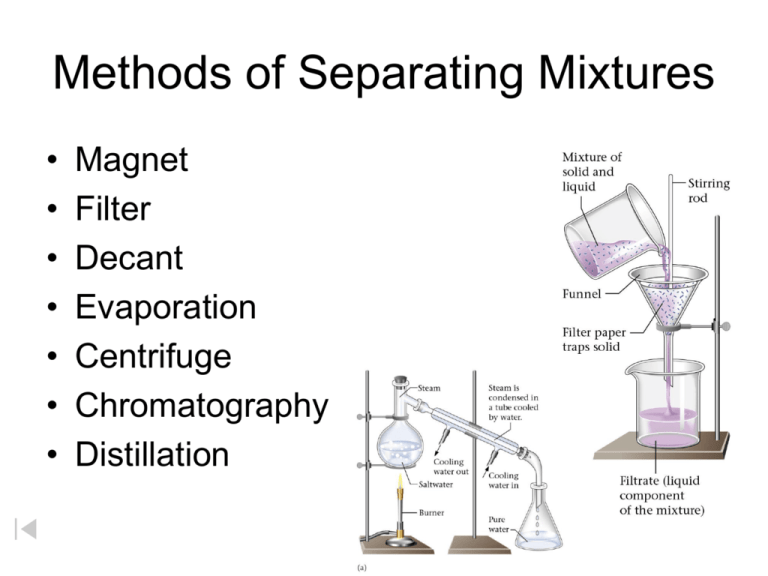
Methods of Separating Mixtures • • • • • • • Magnet Filter Decant Evaporation Centrifuge Chromatography Distillation Mixture of solid and liquid Filtration separates a liquid from a solid Stirring rod Funnel Filter paper traps solid Filtrate (liquid component of the mixture) Zumdahl, Zumdahl, DeCoste, World of Chemistry 2002, page 40 Chromatography • Tie-dye t-shirt • Black pen ink • DNA testing – Tomb of Unknown Soldiers – Crime scene – Paternity testing Paper Chromatography Separation by Chromatography sample mixture a chromatographic column stationary phase mobile phase selectively absorbs sweeps sample components down column http://antoine.frostburg.edu/chem/senese/101/matter/slides/sld006.htm detector Separation by Chromatography sample mixture a chromatographic column stationary phase mobile phase selectively absorbs sweeps sample components down column http://antoine.frostburg.edu/chem/senese/101/matter/slides/sld006.htm detector Ion chromatogram of orange juice detector response K+ Na+ 0 5 Mg2+ Fe3+ 10 15 time (minutes) 20 Ca2+ 25 Setup to heat a solution Ring stand Beaker Wire gauze Ring Bunsen burner Zumdahl, Zumdahl, DeCoste, World of Chemistry 2002, page 42 A Hero’s Fountain Glass retort mixture for distillation placed in here long spout helps vapors to condense Eyewitness Science “Chemistry” , Dr. Ann Newmark, DK Publishing, Inc., 1993, pg 13 Furnace A Distillation Apparatus thermometer liquid with a solid dissolved in it condenser tube distilling flask Dorin, Demmin, Gabel, Chemistry The Study of Matter , 3rd Edition, 1990, page 282 hose connected to cold water faucet receiving flask pure liquid The solution is boiled and steam is driven off. Zumdahl, Zumdahl, DeCoste, World of Chemistry 2002, page 39 Salt remains after all water is boiled off. Zumdahl, Zumdahl, DeCoste, World of Chemistry 2002, page 39 No chemical change occurs when salt water is distilled. Distillation (physical method) Salt Saltwater solution (homogeneous mixture) Zumdahl, Zumdahl, DeCoste, World of Chemistry 2002, page 40 Pure water Separation of a sand-saltwater mixture. Zumdahl, Zumdahl, DeCoste, World of Chemistry 2002, page 40 Separation of Sand from Salt 1. Gently break up your salt-crusted sand with a plastic spoon. Follow this flowchart to make a complete separation. Saltcrusted sand. Calculate weight of salt. Weigh the mixture. Weigh sand. Pour into heat-resistant container. Fill with water. Stir and let settle 1 minute. Decant clear liquid. Dry sand. No 2. How does this flow chart insure a complete separation? Evaporate to dryness. Yes Repeat 3 times? Wet sand. Four-stroke Internal Combustion Engine Different Types of Fuel Combustion Gasoline (octane) 2 C8H18 + 25 O2 16 CO2 + 18 H2O Methanol (in racing fuel) __CH3OH +__O2 __CO2 +__H2O Combustion Chamber -The combustion chamber is the area where compression and combustion take place. -Gasoline and air must be mixed in the correct ratio. The Advantages of Methanol Burning Engines •Methanol can run at much higher compression ratios, meaning that you can get more power from the engine on each piston stroke. •Methanol provides significant cooling when it evaporates in the cylinder, helping to keep the high-revving, highcompression engine from overheating. •Methanol, unlike gasoline, can be extinguished with water if there is a fire. This is an important safety feature. •The ignition temperature for methanol (the temperature at which it starts burning) is much higher than that for gasoline, so the risk of an accidental fire is lower. A Race Car - Basic Information •At 900 hp, it has about two to three times the horsepower of a "highperformance" automotive engine. For example, Corvettes or Vipers might have 350- to 400-horsepower engines. •At 15,000 rpm, it runs at about twice the rpm of a normal automotive engine. Compared to a normal engine, an methanol engine has larger pistons and the pistons travel a shorter distance up and down on each stroke. •The motor is lighter. This lowers their inertia and is another factor in the high rpm. Centrifugation • Spin sample very rapidly: denser materials go to bottom (outside) • Separate blood into serum and plasma – Serum (clear) – Plasma (contains red blood cells ‘RBCs’) AFTER Before Serum Blood RBC’s • Check for anemia (lack of iron) A B C Water Molecules Zumdahl, Zumdahl, DeCoste, World of Chemistry 2002, page 8 The decomposition of two water molecules. Water molecules Diatomic oxygen molecule + Diatomic hydrogen molecules Electric current 2 H2O O2 + 2 H2 Electrolysis “electro” = electricity “lysis” = to split H2O(l) water *H1+ Water Oxygen gas forms Hydrogen gas forms O2 (g) + 2 H2 (g) oxygen hydrogen *Must add acid catalyst to conduct electricity Zumdahl, Zumdahl, DeCoste, World of Chemistry 2002, page 32 Source of direct current Electrode Electrolysis of Water D.C. power source oxygen gas hydrogen gas anode cathode Half reaction at the cathode (reduction): 4 H2O + 4 e - 2 H2 + 4 OH 1Half reaction at the anode (oxidation): 2 H2O O2 + 4 H 1+ + 4 e - water Reviewing Concepts Physical Properties • List seven examples of physical properties. • Describe three uses of physical properties. • Name two processes that are used to separate mixtures. • When you describe a liquid as thick, are you saying that it has a high or low viscosity? Reviewing Concepts Physical Properties • Explain why sharpening a pencil is an example of a physical change. • What allows a mixture to be separated by distillation? Reviewing Concepts Chemical Properties • Under what conditions can chemical properties be observed? • List three common types of evidence for a chemical change. • How do chemical changes differ from physical changes? Reviewing Concepts Chemical Properties • Explain why the rusting of an iron bar decreases the strength of the bar. • A pat of butter melts and then burns in a hot frying pan. Which of these changes is physical and which is chemical?
